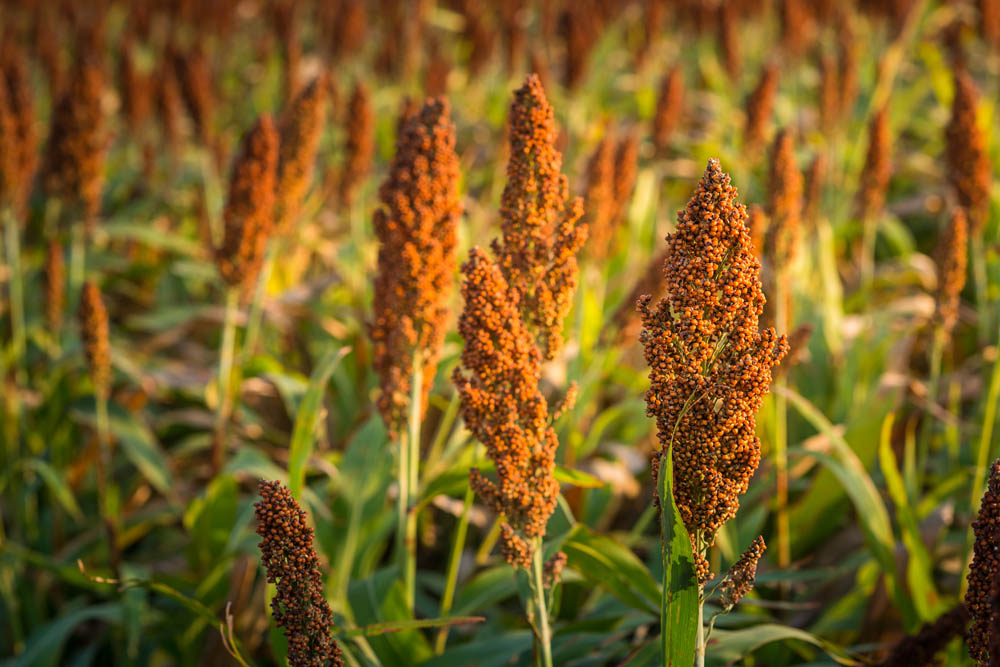- GVP $348 million est. Down 3% year-on-year.
- Production down 18% to 760 thousand tonnes.
- Third consecutive record export value at $409 million, up 77% year-on-year.


Production
Macroeconomic Conditions and Price
International Sorghum Trade 124
- Australian Exports
- United States Exports
- ROW Exports
Another factor affecting the sorghum market was Russia’s invasion of Ukraine. Although Ukraine is a relatively small supplier of sorghum globally, Ukraine feed grain exports accounted for 14% of global trade in the five years to 2022-23. 124 Russia’s invasion of Ukraine and associated feed grain supply disruptions, combined with the drought related supply issues from the US have supported prices, with sorghum prices approximately 20% higher year on year and 7% higher than the five year average. 12
Trade
The record export value was driven by two factors. Firstly increased sorghum production helped provide ample exportable surplus of approximately 782 thousand tonnes (including carryover), with local feed grain sector opting for alternate grains for domestic supplies. Secondly and more importantly strong demand from international markets and in particular China and Japan was reflected by sorghum export prices which were on average 15% higher year on year, averaging $523/tonne. 35 Exports to China accounted for 85% of all NSW sorghum exports by volume, and increased by 34% year on year. Meanwhile exports to Japan, the only other export market of significance, also rose sharply from near negligible levels the year prior to 112 thousand tonnes in 2022-23. 35
Japan was traditionally the largest global importer of sorghum two decades ago with China being a relatively minor import market. However, the picture has since inversed over the past decade, with China far exceeding Japanese import demand due to growing demand for distilling for traditional Baiju liquor, as well as stronger feed grain demand for their intensive livestock industries.
Outlook
Global sorghum production is expected to increase 11% year on year, with production above five-year average levels. The main driver of this increase is an expected recovery in production from the US, which is forecast to more than double production in 2023-24 owing to improved seasonal conditions. 124 The increased production will increase export competition to China, however the lower domestic supply is expected to add some counter support for prices.
Stronger Primary Industries Strategy
New fishing opportunities at Porters Creek Dam
Strategic Outcomes

- 2.2 Support high value, new and emerging industries and new product development

- 6.4 Improve the quality of the natural resource base

The stocking of juvenile Australian Bass in the dam has previously been undertaken by NSW Department of Primary Industries (DPI) with assistance from Shoalhaven City Council. Now that the dam is open, NSW DPI Fisheries plans to stock 2,500 Bass into the dam later this year, to augment the existing fishery at the dam. This work is part of the Native Fish Stocking program and has successfully established a productive fishery for these iconic sportfish. NSW DPI Fisheries will continue to work with Shoalhaven City Council to maintain and promote fishing access at the dam with signage to ensure that the public is aware of these changes. NSW DPI Fisheries Officers will also be patrolling the area to deter illegal fishing.
The dam will be managed in collaboration with the council as a catch and release fly and lure only fishery, that is, no bait fishing allowed. The decision to manage the dam as a catch and release fishery was a condition negotiated between Council and NSW DPI Fisheries. Catch and release fishing also ensures there’s a population of fish available to catch, noting the dam has received only modest stocking rates, as it was previously closed to fishing. Catch and release only using lure and fly will assist in providing opportunities to target “trophy” bass.
DPI’s fish stocking and access programs are supported with funds from the Recreational Fishing Trust and great examples of fishing licence fees being re-invested back into improving recreational fishing. The work done by NSW DPI Fisheries and Shoalhaven City Council to create a new fishery at Porters Creek Dam will provide opportunities that can be enjoyed for generations to come.


